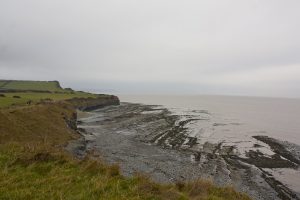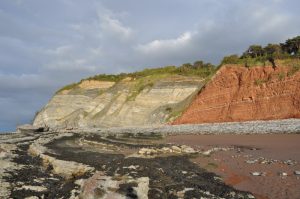
The Fossil-Rich Shores of Somerset
Exmoor, with its beautiful landscapes and rich geological history, is a haven for fossil enthusiasts. From the rocky shores of Kilve Beach to the wide stretches of Doniford Bay, Somerset offers many opportunities for fossil hunting. The recent discovery of the world’s oldest fossilized forest, dating back 390 million years, has sparked new interest in the region’s prehistoric past.
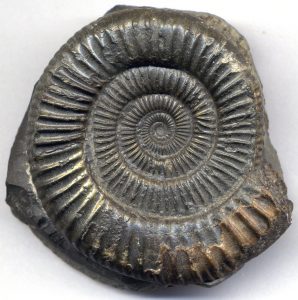 Image by James St. John
Image by James St. John
Kilve Beach: A Fossil Hunter’s Paradise
Kilve Beach, along the Bristol Channel, is famous for its rich fossil deposits. It is a Site of Special Scientific Interest (SSSI) because of its unique geological features and abundance of fossils. At Kilve, you can find ammonites and reptile remains, with vertebrae as common as ammonites. However, you cannot remove fossils from the site due to its protected status.
Kilve Beach is also great for rock pooling and offers a peaceful setting perfect for a family outing. The mix of scientific importance and natural beauty makes Kilve Beach a must-visit spot for fossil hunters and nature lovers.
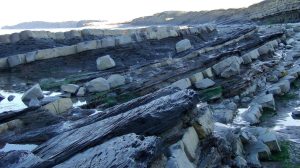
Doniford Bay: Another Fossil Hotspot
A short drive from Kilve Beach, Doniford Bay is another great place for fossil hunters. This area is rich in Jurassic and Triassic fossils. The cliffs and beach reveal many fossils, including belemnites, crinoids, and sometimes even dinosaur bones. The rock formations at Doniford Bay offer a fascinating look into the region’s geological history, making it a must-see for anyone interested in paleontology.
If you time your visit with the tides, you can walk to Watchet.
Doniford Bay Farm offers additional family-friendly attractions like farm animals, food, drinks, and a playbarn, making it a fun day out for all ages.
Discovering the World’s Oldest Fossilised Forest
Researchers recently discovered the world’s oldest known fossilized forest, which dates back 390 million years. This significant find, located in the sandstone cliffs near Minehead, provides a rare glimpse into a world that existed long before dinosaurs. The fossils belong to ancient trees called Calamophyton, which looked like modern palm trees with thin, hollow trunks and twig-like branches.
This discovery shows how important the Devonian period was in shaping Earth’s landscapes and ecosystems. The fossilized forest, found in the Hangman Sandstone Formation, reveals how early trees helped stabilize riverbanks and coastlines, changing how water and land interacted.
For more detailed information, you can refer to articles from the West Somerset Free Press and Cambridge University.

How to Go Fossil Hunting Safely
Fossil hunting is fun and educational, but it’s important to do it safely and responsibly. Here are some tips to help you enjoy your fossil-hunting adventures while staying safe and protecting these precious resources.
- Understand the UK Fossil Code
Learn the UK Fossil Code, which provides guidelines for responsible fossil collecting. This code stresses the importance of preserving scientific information and protecting geological sites. - Check the Tides
Always check tide times before heading out. Fossil hunting is best at low tide when more of the beach is exposed. This increases your chances of finding fossils and keeps you safe from getting trapped by the incoming tide. - Wear the Right Clothing
Dress for the conditions. Wear sturdy shoes with good grip to navigate the rocky and often slippery terrain. Layered clothing and waterproof gear can protect you from the unpredictable coastal weather. - Bring the Right Tools
If tools are allowed, a small geological hammer, chisel, and brush can be useful. However, at Kilve Beach, no hammering is allowed due to its SSSI status. Always be mindful of the environment and avoid unnecessary damage to rocks. - Avoid Cliff Faces
Cliffs can be unstable and prone to rockfalls. Keep a safe distance from the base of cliffs and never climb them. Stick to searching on the beach and exposed rock platforms. - Respect the Environment
Leave the area as you found it. Avoid littering and respect the natural habitat. If you find significant fossils, report them to local museums or geological societies to help with scientific research.
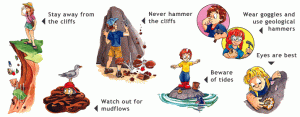
The History of Fossils in Somerset
The history of fossil discovery in Somerset is rich and varied. The region’s geological formations, ranging from the Jurassic to the Triassic periods, have long attracted geologists and fossil hunters. Somerset’s fossil record provides crucial evidence of the prehistoric environments and the diverse life forms that existed millions of years ago. Over the centuries, numerous significant finds have been made, contributing to our understanding of Earth’s history and the evolution of life.
Fossil hunting on Exmoor offers a unique way to connect with the ancient past. From the ammonites of Kilve Beach to the dinosaur remains of Doniford Bay, Somerset’s coastline is a living record of the rich life that once existed on our planet. By following safety guidelines and respecting the environment, you can enjoy this fascinating hobby while helping to preserve our natural heritage. So grab your gear, head to the coast, and start your fossil-hunting adventure!
Accommodation on Exmoor
After a day of exploring Exmoor’s fossil-rich landscapes, you can relax and unwind in one of our self-catering accommodations. Our properties offer a comfortable base for your adventures, with easy access to Kilve Beach, Doniford Bay, and other local attractions. Enjoy the beauty of Exmoor while staying in a cozy, fully-equipped home away from home.
Resources
– For more on the world’s oldest fossil forest, check out the detailed articles from [West Somerset Free Press] [BBC] and [Cambridge University].
Happy fossil hunting!

